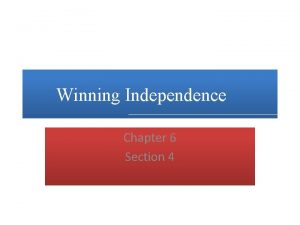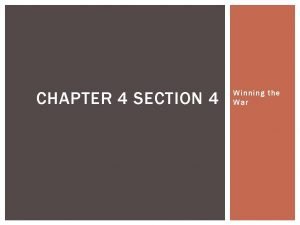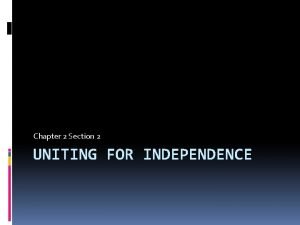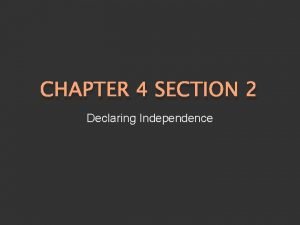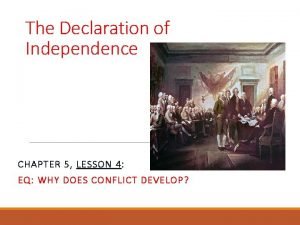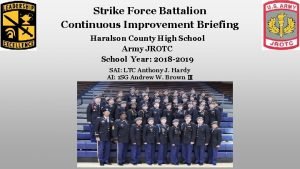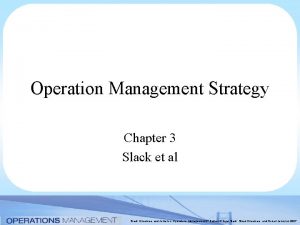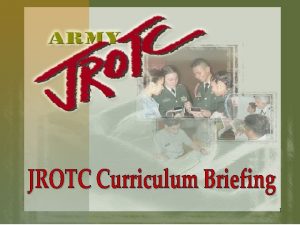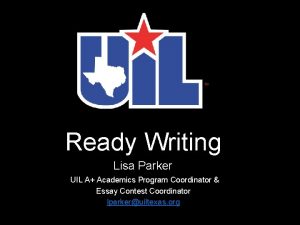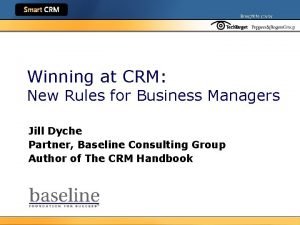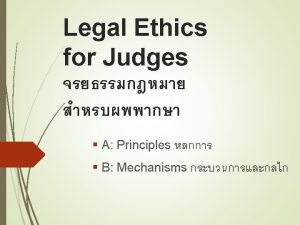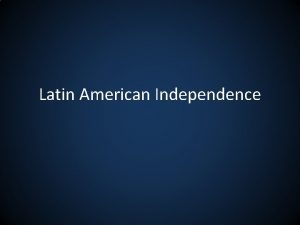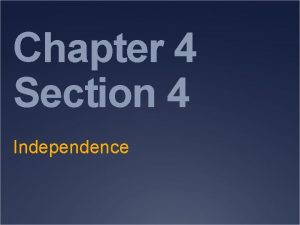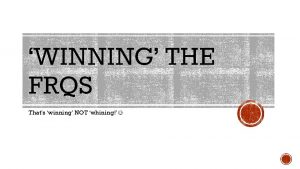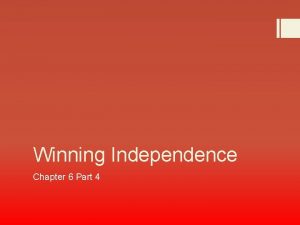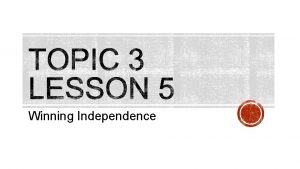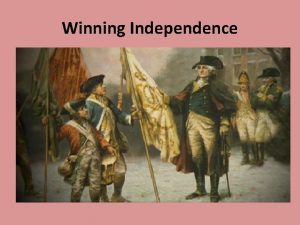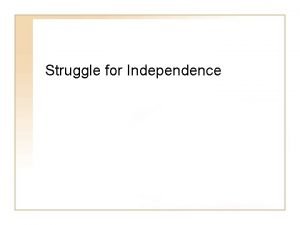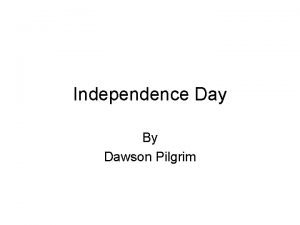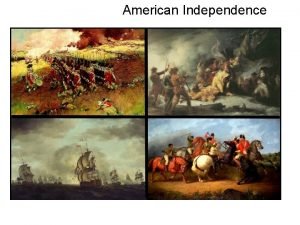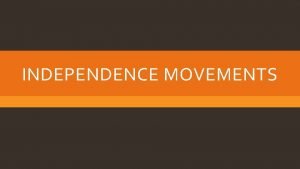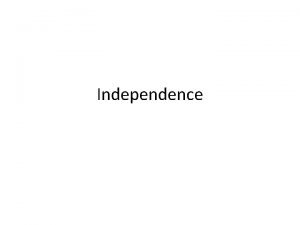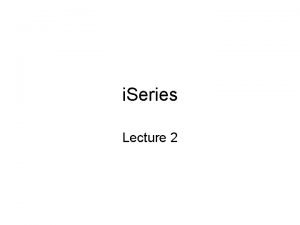Winning Independence Chapter 6 Section 4 Why It



















- Slides: 19

Winning Independence Chapter 6 Section 4

Why It Matters • After the American victory at Saratoga, the British threat to New England had ended. • The British next tried to win the war by invading and capturing the South. • The attempt failed and the Americans won their independence.

Fighting Moves South • The British turned to the South in late 1778. Their aim was to capture some key cities, win over the local population, and then march north to seize each state one-by-one. • At first, Britain’s plan seemed to work. British soldiers moved north from Florida into Georgia, and in December of 1778, they took the city of Savannah. Within a month the British controlled all of Georgia.

British Advance • The British continued on towards South Carolina where they captured the main port of Charles Town, then were able to seize the rest of the state. • British Commander, Lord Charles Cornwallis, then marched his troops into North Carolina. • The British were seizing a lot of land in a short period of time and it appeared as if they were unstoppable.

British Advance • To slow the British advance, Americans used guerilla tactics. Guerillas are fighters who work in small bands to make hit-and-run attacks. • Francis Marion fought with guerillas. He led his men silently through swamp areas where they would attack the British without warning, then they would escape. • Marion’s guerilla attacks were so efficient that he won the nickname Swamp Fox. • There were several other bands of guerillas that were active during this period of the war.

British Advance • Elsewhere in the South, Loyalist bands roamed the backcountry plundering Patriot’s homes and farms as well as killing several men, women, and children. • One Continental General wrote, “If a stop cannot be put to these massacres, the country will be depopulated in a few months more. ”

Brighter Days • Patriot fortunes began to improve in October of 1780. Some 900 frontier fighters defeated a larger force of British troops and Loyalists atop Kings Mountain in South Carolina. • In December of 1780, General Nathanael Greene took over command of the Continental army in the south. • Greene split his small army in two, and led 1, 200 men into eastern South Carolina, leaving 800 men in the west underneath another General; Daniel Morgan.

Brighter Days • In January 1781, General Morgan won a clear victory at the Battle of Cowpens. • He put a small militia force in front, telling his men to fire three shots then retreat. • The British rushed their forces forward, only to be met by a charging cavalry and a line of skilled riflemen.

American Traitor • The British still seemed to have the upper-hand in the South even with Patriot victories. • In addition to Cornwallis’ forces, the British had troops under the command of an American defector and traitor, named Benedict Arnold. A traitor is a person who betrays his or her country or cause and helps the other side.

American Traitor • Early in the war, Arnold had fought bravely for the Patriots, but he felt Congress undervalued him. • He plotted to turn over West Point, a key fort on the Hudson River in New York, over to the British. • When Arnold’s plot was discovered, he was able to escape. He and his Loyalist soldiers then staged a series of destructive raids in Virginia.

Final Battle • Cornwallis’ forces were weakened after battles like the one at Cowpens. He heads towards Virginia. • Over a five-month period, Patriot forces swept through the Deep South. By the summer only Charles Town and Savannah remained in the British’s hands. • Cornwallis then makes a fateful mistake. He moved his main army to the Yorktown peninsula. There, he thought, the British fleet could reinforce his position. • The French fleet arrived off Yorktown and chased off Britain’s ships.

Final Battle • At the same time that British ships are being blocked by the French, Washington marches to Virginia with American and French troops. • Cornwallis found himself in a trap. American and French troops blocked off any escape by land, and the French fleet blocked any sea escape. • After three weeks of fighting, Cornwallis had no other option but to surrender.

Final Battle • On October 19, 1781, American and French troops lined up in two facing columns. British troops glumly marched between the columns and tossed their weapons into a large pile. • The victory at Yorktown was the last major battle of the war.

Making Peace with Britain • The news of Cornwallis’ surrender at Yorktown sent shockwaves through the British Empire. King George III wanted to keep fighting, but the British Parliament voted in favor of peace. • Peace talks began in Paris in 1782. The American delegation included Benjamin Franklin and John Adams. • Britain was eager to come to peace terms so the Americans got most of what they wanted.

Treaty of Paris • Peace talks led to an agreement, the Treaty of Paris. • Britain recognized the independence of the United States. The boundaries of the new nation were set at the Atlantic on the east, Canada on the north, the Mississippi River on the west, and Florida on the south. Florida was returned to Spain. • The United States agreed to “earnestly recommend” that the states restore rights and property taken from Loyalists during the war. However, most states ignored this pledge.

Treaty of Paris • Congress approved the treaty on April 15, 1783. The war was officially over. • It had been almost exactly eight years since the “shot heard around the world” started the fighting in Lexington.

Washington’s Farewell • On December 4, 1783, Washington and his ranking officers were reunited for one last meal together In New York City. • Officers showed appreciation for Washington’s efforts by embracing him before the dinner broke up. • One officer wrote, “Such a scene of sorrow and weeping, I had never before witnessed. ” • Washington planned on retiring to his plantation, but he would soon be called upon again to aid the nation he helped to create.

Impact of the Revolution • The immediate effect of the American Revolution was to create a new nation of 13 independent states. • The long term-effect of the war are still felt today. The Declaration of Independence cemented ideas like equality and liberty in the Americans mind. Over time, those concepts have gained broader meaning.

Impact of the Revolution • The impact of American independence reached beyond the 13 states. In 1789, French citizens rebelled sparking their own revolution. • Leaders of the French Revolution, looked to the American example. They issued the Declaration of Rights of Man and the Citizen, modeled in part after the Declaration of independence. • The American Revolution would also inspire later independence movements in Latin America.
 Chapter 6 section 4 winning independence
Chapter 6 section 4 winning independence Chapter 4 section 4 winning the war
Chapter 4 section 4 winning the war Pictures
Pictures Chapter 8 section 1 latin american peoples win independence
Chapter 8 section 1 latin american peoples win independence Lesson 2 uniting for independence
Lesson 2 uniting for independence Chapter 4 section 2 declaring independence
Chapter 4 section 2 declaring independence Dont ask
Dont ask Lesson 4 declaring independence
Lesson 4 declaring independence Winning hearts and minds manchester
Winning hearts and minds manchester Green winning color
Green winning color Misere nim
Misere nim Classes of supply army
Classes of supply army Slack et al model of operations management
Slack et al model of operations management Core abilities
Core abilities Mission and vision of ecwa
Mission and vision of ecwa Uil ready writing rubric
Uil ready writing rubric Keno 603 winning numbers
Keno 603 winning numbers Winning executive summary
Winning executive summary Crm.winning.cb
Crm.winning.cb Up student plagiarizes prize-winning photos
Up student plagiarizes prize-winning photos
